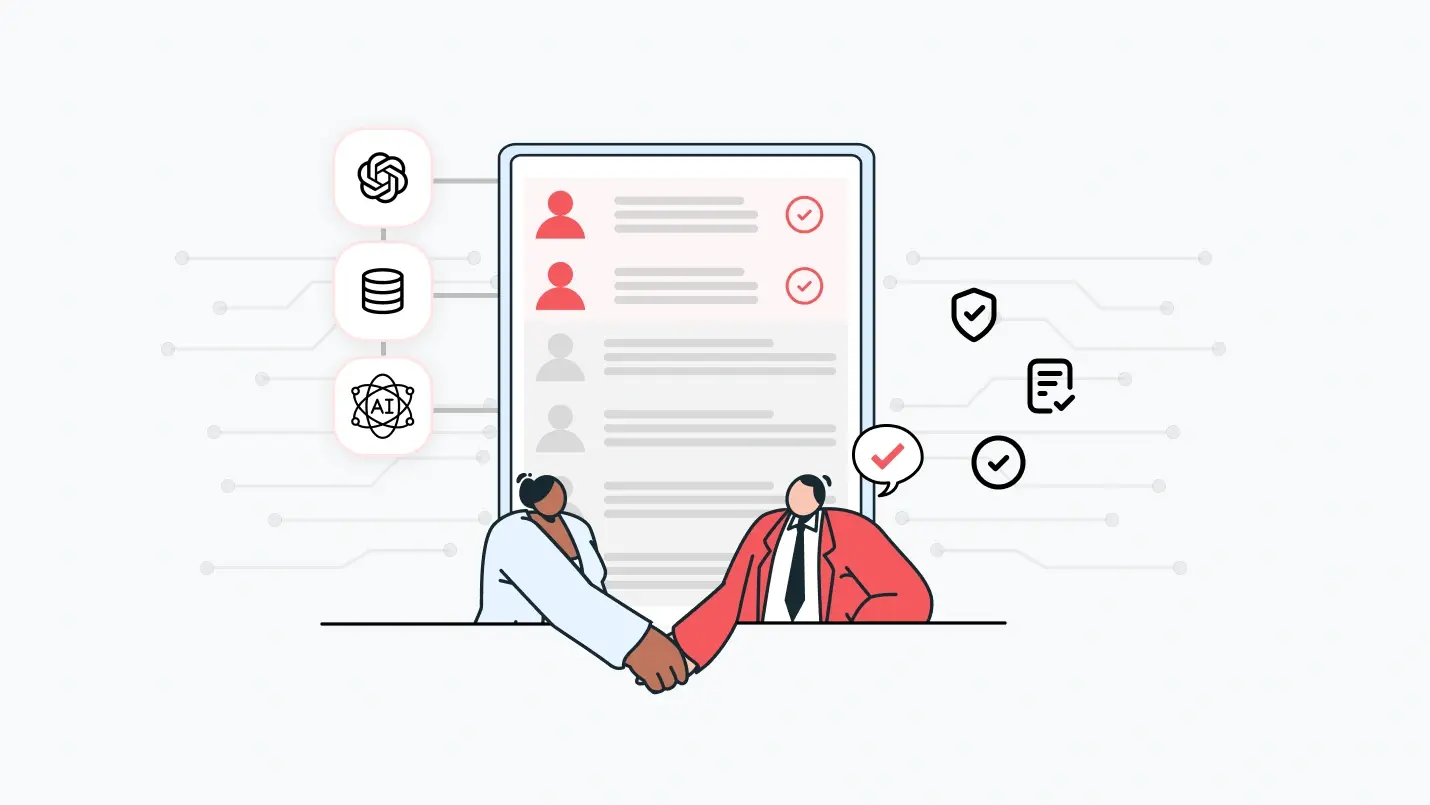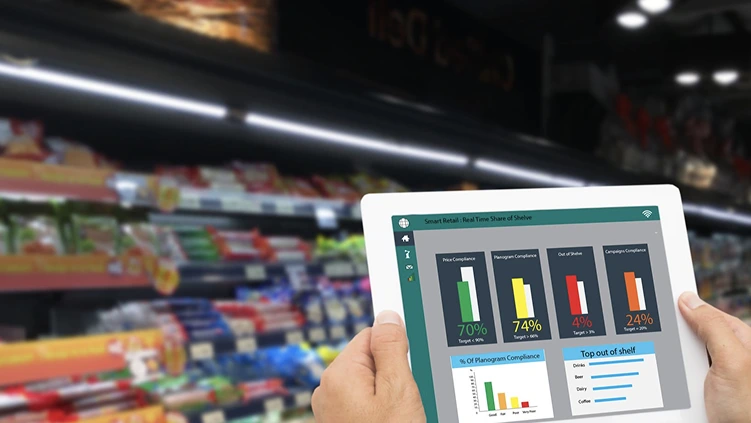The Procurement Predicament: Why Manual Processes Hold Businesses Back
Clinging to outdated procurement practices is more than just inefficient; it actively impedes growth. Traditional, manual procurement processes, which often rely heavily on spreadsheets, emails, and paper trails, act as an unseen anchor, significantly dragging down operational speed and limiting strategic potential. These conventional methods introduce hidden costs that extend far beyond mere administrative burdens.
Key Challenges of Manual Procurement
- Inefficiency and Time Drain: Manual work is super slow and eats up time. Entering orders, chasing approvals, and matching invoices is all repetitive and delays everything. Procurement teams just react to problems, constantly “fighting fires” instead of planning smart. This means they miss out on better opportunities.
- High Error Rates: People make mistakes, and in manual systems, that costs a lot. Wrong orders, double payments, missed discounts, these “small mistakes add up fast,” losing money. Plus, making and keeping records manually is error-prone, hurting your finances.
- Ineffective Supplier Contract Management: Manual processes make managing suppliers and contracts tough. Tracking performance, risks, or renewal dates is hard with scattered files. Important details get lost, leading to bad deals and missed chances.
- Compliance Risks: Manual buying systems have big holes for policy and rule-following. Weak audit trails make it hard to control spending, increasing fraud risk, fines, and reputation damage, especially in strict industries. Keeping vendor info secure is also super hard without automated systems.
All these problems together aren’t just inconvenient; they stop companies from growing and innovating. The time and money wasted on these inefficiencies are huge missed opportunities. Fixing procurement isn’t just about saving cash; it’s essential for a flexible and competitive business. Companies still using manual processes aren’t just inefficient; they’re hurting their future.
The business world is getting more complex, and rules are getting tighter, especially in places like food manufacturing. This means manual processes, already error-prone and hard to check, become way riskier. Automation isn’t a luxury anymore; it’s a must-have. Soon, manual compliance could be disastrous, leading to fines, recalls, and bad reputations.
A New Era of Efficiency: Introducing the RAG & LLM Advantage
The challenges of manual procurement highlight a clear need for advanced solutions.
AI in procurement isn’t adopted all at once—it follows a maturity curve. Most organizations start with prompt-based experiments, then embed AI into specific procurement functions, and eventually transition to integrated, enterprise-wide solutions. This three-phase adoption model helps clarify how businesses evolve from experimentation to transformation.
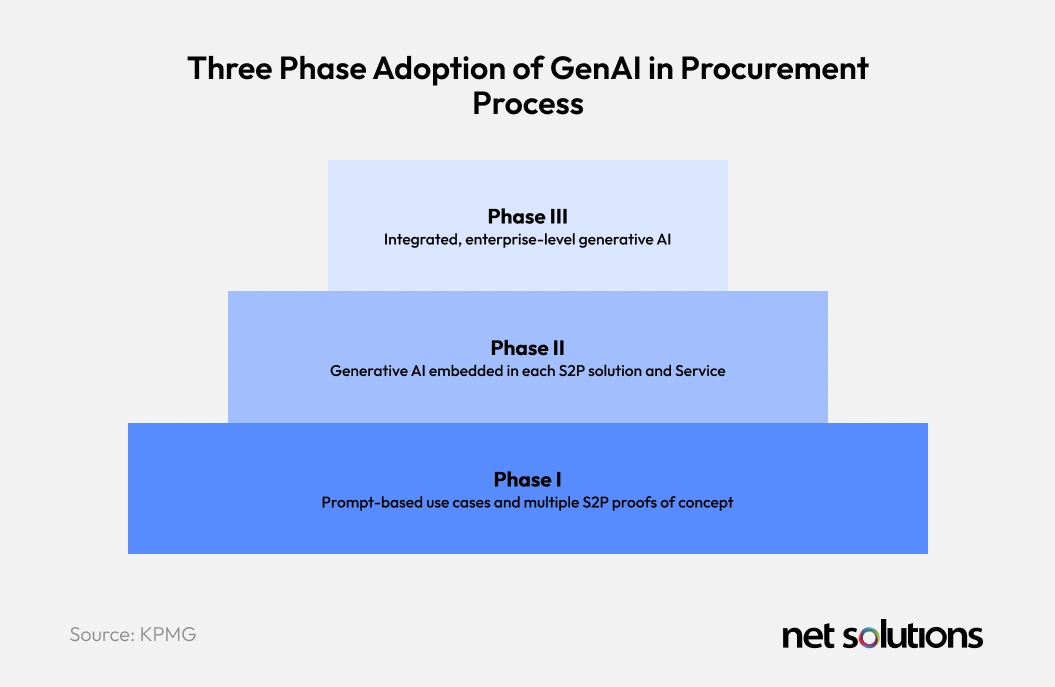
This is where Large Language Models (LLMs) and, more specifically, Retrieval-Augmented Generation (RAG) emerge as transformative technologies. LLMs are super smart AI trained on tons of text. They create human-like responses for questions, summaries, and more, totally changing how businesses use information. Basic LLMs have big limits for business. Their knowledge gets old, and they can sometimes make stuff up (“hallucinations”). That’s just not good enough for serious business needs. RAG is a cool new way to fix LLM problems, making them truly useful for businesses. RAG makes LLMs better by telling them to check a reliable knowledge base outside their original training. This means the LLM isn’t guessing; it’s using real, up-to-date company info for accurate answers.
How RAG Delivers Business Value
RAG boosts LLMs by adding external data through smart tech:
- Access to Updated and Company-Specific Knowledge: RAG connects AI to your company’s unique knowledge, pulling current info like policies or product specs. This is huge for getting precise answers.
- Minimizing Hallucinations and Enhancing Accuracy: RAG drastically cuts down errors and “hallucinations” by using info directly from official documents. Responses are reliable and can even show where they came from.
- Enhanced Transparency and Explainability: RAG lets you see where AI answers came from, which is great for trust and meeting new AI rules.
- Adaptability and Scalability: RAG is super flexible. Instead of costly retraining, it just gives LLMs access to updated external info. This makes AI systems easy to keep current.
This shift from unreliable AI to accurate, compliant AI using your own data is a big deal. It moves AI from a “boardroom curiosity” to a “must-have” for critical business tasks, especially in regulated industries like banking. It turns AI from a mystery box into a clear, checkable tool.
Plus, RAG is a cheaper, simpler way to customize AI than traditional fine-tuning. By letting LLMs access external knowledge without needing to retrain them, RAG avoids expensive, long tasks. This makes advanced AI more accessible for more businesses, even medium-sized ones. It means less focus on complex AI development and more on smart data handling, letting business experts shape AI’s use.
Real-World Impact: Transforming Vendor Assessment in Food Manufacturing
The theoretical advantages of RAG and LLMs translate into tangible benefits in specific industry contexts, as demonstrated by a recent project in food manufacturing.
The Specific Challenge in Food Manufacturing
Food manufacturers are under huge pressure to be compliant, especially with sustainability and tracing ingredients. When making new products, checking and scoring ingredient suppliers against tough rules is super important. This usually means sifting through tons of supplier papers, which is a big hassle. Things like certifications and reports expire, so you’re constantly tracking and reviewing them. This manual work is a major bottleneck, full of mistakes and delays.
Strategic Importance for New Product Development
For a food company, being able to quickly and accurately vet ingredient suppliers is a must for new product planning. The automated system launched means new products can hit the shelves much faster, with confidence that all suppliers meet strict compliance and sustainability rules.
Manual compliance in the food industry is often a “burden” that makes teams “demotivated” and increases “non-compliance risk.” The “drastic time reduction” and “elimination of errors” mean procurement teams aren’t stuck doing repetitive data entry and chasing documents. This frees them up for more important stuff like strategic sourcing and building better supplier relationships. The system doesn’t just process data; it helps make faster, smarter decisions crucial for new product development. This shows AI in procurement isn’t just about saving money; it turns procurement from a reactive role into a proactive one that boosts innovation. It shifts people from “mechanical” tasks to “strategic and creative” ones.
Also, focusing on “compliance with various sustainability metrics” for vendors directly tackles a big risk area. No more errors means less chance of bad ingredients getting into the supply chain. This isn’t just about rules; it’s about protecting the company’s brand, avoiding costly recalls, and building customer trust. Automating vendor checks, especially for compliance, moves companies from fixing problems after they happen to preventing them. This is huge for long-term company strength and brand value, especially where safety and quality are everything.
Broader Benefits of AI in Procurement
The success observed in the food manufacturing project is not an isolated incident. Across diverse industries, AI-powered solutions, particularly those leveraging RAG and LLMs, are fundamentally revolutionizing procurement, transitioning it from a mere cost center to a powerful strategic enabler. The widespread adoption of AI in procurement is reshaping how organizations manage their supply chains and vendor relationships. This shift is driven by the ability of AI to automate complex processes, provide deep insights, and enhance decision-making across various procurement functions.
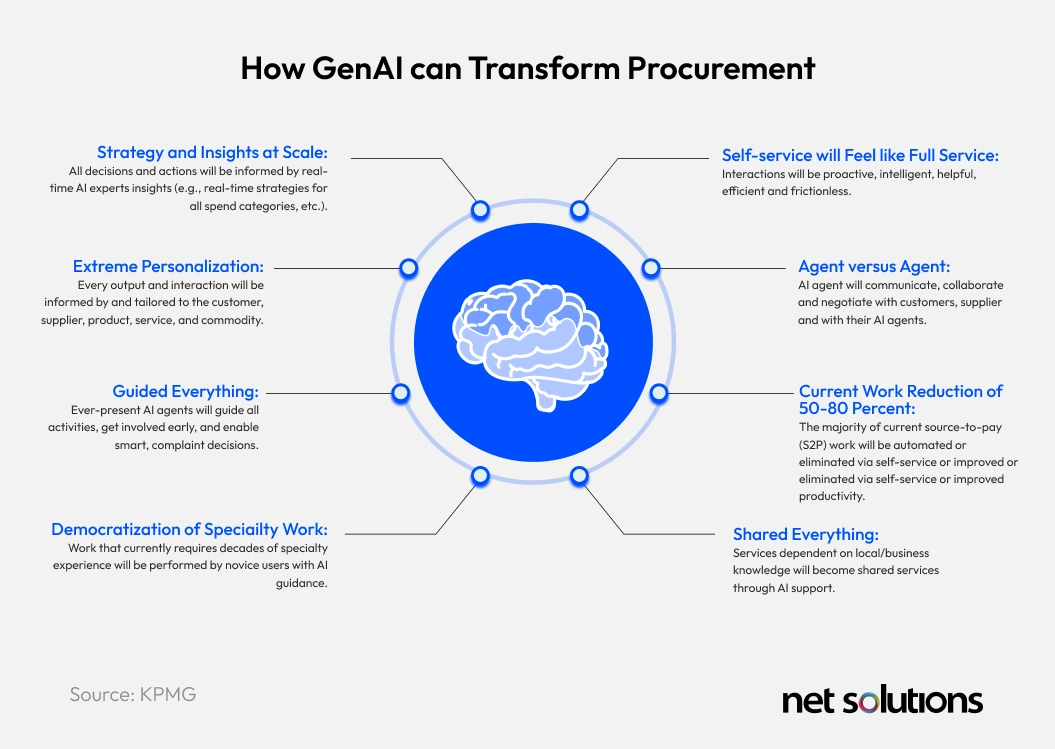
Quantifiable Efficiency Gains
AI’s ability to automate routine, repetitive tasks significantly frees up procurement staff, allowing them to focus on more strategic activities.
- Studies indicate that AI can reduce the time required for basic procurement tasks by up to 80% (Source: KPMG).
- A commercial property developer, for instance, reported collecting procurement data 92% faster with AI compared to manual methods. (Source: AI Multiple Research)
- Procurement functions that use AI can reduce overall costs by roughly 15% to 45% (depending on the category) and eliminate up to 30% of the work for employees and teams.
Unprecedented Accuracy and Reduced Errors
By automating repetitive tasks, AI drastically reduces the potential for human error. Automated procurement solutions enforce checks and flag discrepancies, thereby significantly reducing financial exposure.
- One water treatment company notably improved the accuracy of its procurement spending classification by over 90% using AI.
- Optimized RAG techniques have boosted accuracy in commercial contract reviews from 74% to an impressive 95%.
- Proprietary GPTs can quickly flag nonstandard liability clauses across hundreds of supplier agreements, slashing legal review time by 80%.
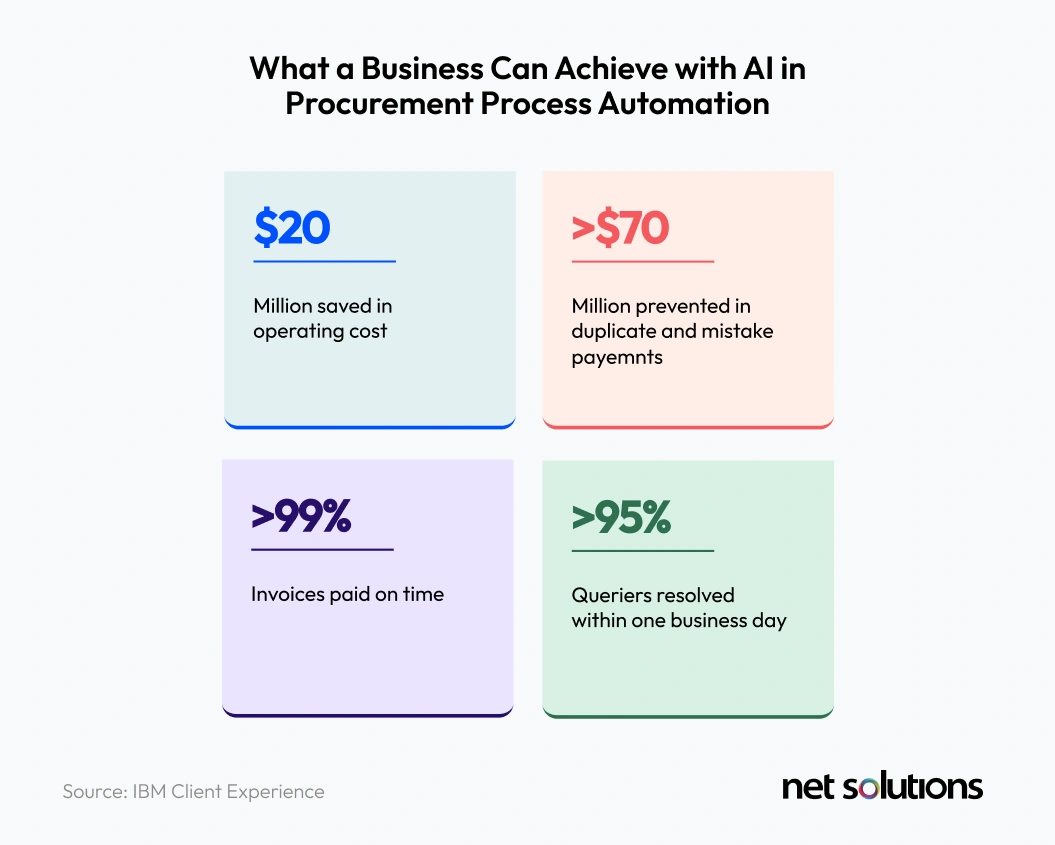
Significant Cost Reductions and Enhanced Negotiation
AI provides deeper insights into spend across various categories, recommending specific steps to achieve lower costs.
According to the IBM Institute for Business Value report “Smart procurement made smarter,” companies that use AI in procurement are seeing measurable outcomes such as:
- 40% to 70% reduction in procurement costs within six months through AI-driven category intelligence and predictive analytics
- Onboarding suppliers 10 times faster and reducing pricing analysis time from two days to 10 minutes by automating manual processes and enabling data-driven decision-making
- Over USD 70 million prevented in duplicate and mistaken payments, along with increased contract compliance and risk mitigation through AI-driven supplier agreement analysis
- Stronger supplier relationship management, by using AI-driven insights to enhance negotiations and performance tracking
- Improved sustainability efforts, as AI identifies opportunities for greener, more responsible sourcing
Enhanced Risk Management and Compliance
AI empowers procurement managers to predict and react more effectively to market conditions and mitigate supply chain risks.
- It can proactively identify and mitigate potential risks, leading to a 20% reduction in supply chain disruptions.
- Automated systems embed policy rules and approval limits directly into workflows, preventing non-compliant purchases before they occur.
- AI ensures improved compliance with procurement policies, resulting in more consistent and transparent processes.
Strategic Focus and Decision-Making
By automating low-value, high-volume tasks, AI frees procurement teams to concentrate on strategic activities such as spend analysis, financial forecasting, and supplier innovation.
- AI and analytics can pull data from numerous sources—including general ledgers, purchase orders, and supplier transactions—faster than ever before, providing crucial insights for informed decision-making.
- Furthermore, AI systems possess the ability to adapt and learn, continuously producing increasingly precise analysis and impactful recommendations.
The numerous examples of significant, measurable returns on investment (ROI) from AI in procurement are not just isolated improvements; they represent a consistent pattern of substantial gains. The dramatic reduction in the cost of running AI queries—a 280-fold collapse from late 2022 to mid-2025—makes these solutions economically viable for a broader range of businesses, transforming AI from a “boardroom curiosity into a line-item purchase”. This signals a market shift where AI in procurement is no longer an experimental luxury but a core competitive differentiator and a fundamental requirement for operational excellence and financial health. Businesses that do not adopt these technologies risk falling behind in efficiency, cost management, and overall agility.
Traditionally, procurement has often been perceived as a cost center or primarily an administrative function. However, the collective benefits outlined—improved efficiency, reduced errors, significant cost savings, enhanced risk management, and superior decision-making—demonstrate that AI empowers procurement to become a proactive, value-adding strategic partner. By automating mundane tasks, procurement professionals can shift their focus to strategic sourcing, mitigating supply chain risks, fostering supplier innovation, and engaging in demand forecasting. This transition allows procurement to contribute directly to both top-line growth (e.g., through faster new product development) and bottom-line savings, rather than merely executing purchases. This redefines the role of procurement within the enterprise, transforming it into a high-impact function that drives competitive advantage, resilience, and innovation.
The Role of Platforms like AWS Bedrock
While AI in procurement sounds great, actually using and managing these fancy AI solutions can be tough. They often need a lot of expensive tech setup and super-specialized AI experts. Many AI projects get ditched after the initial trial because of these very difficulties. That’s where platforms like AWS Bedrock shine.
AWS Bedrock: Simplifying Enterprise AI
AWS Bedrock is a service from Amazon that makes building and scaling AI apps a breeze. It basically handles all the tricky behind-the-scenes tech stuff, so businesses can just focus on making their apps awesome instead of worrying about hardware or maintenance.
- Access to Diverse Foundational Models (FMs): Bedrock gives you easy access to the best AI models from top providers like Anthropic, AI21 Labs, Cohere, and Stability AI, all through one simple connection. This means you can pick the perfect model for whatever task you’re working on, without being stuck with just one option.
- Customization with Proprietary Data: A super important feature for any business app is being able to tweak AI models with your own company’s data. This ensures the AI’s answers are spot-on, relevant to your business, and follow your company’s rules.
- Scalability and Cost-Effectiveness: Bedrock works on a “pay-as-you-go” system, meaning your AI apps can grow instantly without you needing to manage any dedicated tech. This significantly cuts down on costs and makes AI adoption way more affordable, turning a big upfront expense into a more manageable ongoing one.
The Future of Procurement: Smarter, Faster, More Strategic
The journey from the hidden costs and pervasive inefficiencies of manual procurement to the streamlined, accurate, and strategically empowered operations enabled by RAG and LLMs is truly profound. As demonstrated by the specific project in food manufacturing and numerous other industry examples, artificial intelligence is not merely an incremental improvement; it represents a fundamental shift in how procurement functions within an organization.
The Inevitable Shift
The increasing complexity of global supply chains, intensifying compliance pressures, and the sheer volume of data that businesses must manage necessitate a decisive move away from outdated practices. In this environment, “automation is becoming not a luxury, but a necessity”. The dramatic reduction in the operational costs associated with AI further solidifies its position as a mainstream enterprise technology, making its adoption not just desirable but economically imperative.
Procurement’s New Role
AI empowers procurement teams to shed their administrative burden and embrace a truly strategic role within the enterprise. With routine tasks automated, procurement professionals can redirect their focus to higher-value activities:
- Proactive Risk Management: Anticipating and mitigating supply chain disruptions before they escalate, ensuring business continuity.
- Strategic Sourcing & Negotiation: Leveraging comprehensive data analytics for optimal supplier relationships and achieving significant cost savings.
- Innovation & Collaboration: Actively driving new product development by identifying and fostering partnerships with innovative suppliers.
- Enhanced Compliance & Governance: Ensuring robust, transparent, and auditable processes that meet evolving regulatory demands.
The cumulative benefits of AI in procurement—including drastic time savings, substantial error reduction, significant cost cutting, and enhanced risk management—directly contribute to a more robust and responsive organization. In a volatile global economy characterized by increasing supply chain complexities, the ability to quickly vet vendors, manage compliance, and adapt swiftly to market conditions is paramount for business continuity and competitive survival. AI enables procurement to transition from reactive problem-solving to proactive strategic planning, thereby making the entire supply chain more resilient. This positions AI in procurement not just as an operational improvement tool, but as a core component of an organization’s overall strategy for risk management, business continuity, and market agility. It is about building an enterprise that can not only survive but thrive amidst disruption.
The Competitive Imperative
Businesses that strategically embrace AI in procurement will gain a significant competitive advantage. They will operate faster, exhibit greater agility, achieve superior cost-effectiveness, and demonstrate enhanced resilience in the face of market changes and unforeseen disruptions. This transformation is not solely about achieving efficiency; it is about constructing a future-ready enterprise capable of sustained growth, continuous innovation, and enduring market leadership.
As AI automates routine tasks, the role of the human procurement professional undergoes a fundamental shift. Instead of being consumed by manual data entry and the tedious process of chasing paperwork, their time is liberated for strategic sourcing, mitigating supply chain risks, driving supplier innovation, and engaging in enhanced decision-making. This transformation implies a pressing need for upskilling the workforce to cultivate analytical capabilities, strategic thinking, advanced negotiation skills, and sophisticated relationship management.
The human expert’s value shifts from transactional execution to strategic oversight and the insightful interpretation of AI-generated information. This underscores that human expertise remains crucial, but its application evolves, leveraging AI as a powerful co-pilot rather than being replaced by it.

